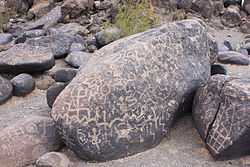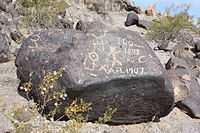Painted Rock Petroglyph Site
|
Painted Rock Petroglyph Site | |
 | |
| Nearest city | Theba, Arizona |
|---|---|
| Coordinates | 33°1′24″N 113°2′55″W / 33.02333°N 113.04861°WCoordinates: 33°1′24″N 113°2′55″W / 33.02333°N 113.04861°W |
| Architectural style | Petroglyphs |
| Governing body | State |
| NRHP Reference # | 77000238 |
| Added to NRHP | November 25, 1977 |
The Painted Rock Petroglyph Site[1] is a collection of hundreds of ancient petroglyphs near the town of Theba, Arizona, listed on the National Register of Historic Places in 1977.[2] The site is operated and maintained by the Bureau of Land Management (BLM), and includes an improved campground as well as an informative walking trail showcasing the petroglyphs.[3]
Prior to 1989, the site was part of Painted Rock State Park, which included camping facilities on the nearby Painted Rock Reservoir, referred to as the "Lake Unit". When the state turned control of the park over to the BLM in 1989, the Lake Unit was closed due to concerns over pollutants in the Gila River and is not maintained by the BLM. Currently, there is no public access to Painted Rock Dam or the Lake Unit.[1]
History

The Painted Rock Petroglyph Site is located on the eastern edge of the Painted Rock Mountains and about eighteen miles west by northwest of Gila Bend, Arizona. The area is mostly flat and sandy with May-Oct daytime temperatures in the 100s. The annual rainfall is only about six inches and the nearest irrigational water is the Gila River. In prehistoric times the Gila flowed west out of the mountains of western New Mexico, made a big dogleg turn at the town of Gila Bend and continued west to empty into the Colorado River. The Hohokam people once lived and farmed here. Ruins of their late Pioneer Period (AD 350 - AD 550) and Early Colonial Period (AD 550 - AD 700) villages are found to the north and west, and ruins of their Sedentary - Classic Period (AD 900 - AD 1400) villages are found to the south and east.[3]
Over forty petroglyph sites have been recorded in the area, however; most of these sites are small with only a few dozen petroglyphs. The Painted Rock Site is the largest known site with about 800 images. The petroglyphs are pecked onto weathered basalt boulders overlaying a granite outcrop. The outcrop is in the form of an east to west orientated oval about 400' long, and about 20' tall with two small knob tops. Most of the petroglyphs are concentrated on the boulders along the eastern edge, but the petroglyphs face in all directions from that edge.[3]
Although considered a Hohokam rock art site, Painted Rock is on the extreme western edge of the Hohokam cultural area. As you travel east from Painted Rock the petroglyphs take on more typical Hohokam characteristics, and as you travel further west, the petroglyphs take on more Patayan characteristics. Found here and in nearby areas of the Gila River are petroglyphs of Archaic origin. Painted Rock also bears the inscriptions of historic passers-by. Juan Bautista de Anza passed near here during his 1775-1776 expedition, followed by the Mormon Battalion in the 1840s, the Butterfield Overland Mail, and countless numbers of pioneers. During World War II, General George Patton used this area as headquarters for tank training.[3][4]
Similar petroglyphs
Fifteen miles up the Gila River in the Gila Bend Mountains there are similar ancient petroglyphs with stick figures with long, wavy headdresses and solid circles in the middle of their bodies. These are not common in other parts of the American Southwest.[5]
See also
- Cocoraque Butte Archaeological District
- History of Arizona
- Newspaper Rock State Historic Monument
- Painted Rocks
References
- ↑ 1.0 1.1 "Painted Rock Petroglyph Site". Retrieved 2014-01-15.
- ↑ "National Register Information System". National Register of Historic Places. National Park Service. 2009-03-13.
- ↑ 3.0 3.1 3.2 3.3 "Hohokam and Patayan petroglyphs at Painted Rock Petroglyph Site, Gila Bend, Arizona". PETROGLYPHS.US. Retrieved 2014-01-15.
- ↑ "Painted Rock Petroglyph Site". Bureau of Land Management. Retrieved 2009-06-11.
- ↑ Wilson, Dave (1999) "Gila Bend Mountain Ruin" Hiking Ruins Seldom Seen Falcon Publishing, Helena, Montana, pp. 31-32, ISBN 1-56044-834-2
| ||||||||||||||||||||||||||||||||||||||||||||||||||||||||||||||||||||||||||||||
| ||||||||||||||||||||||||||